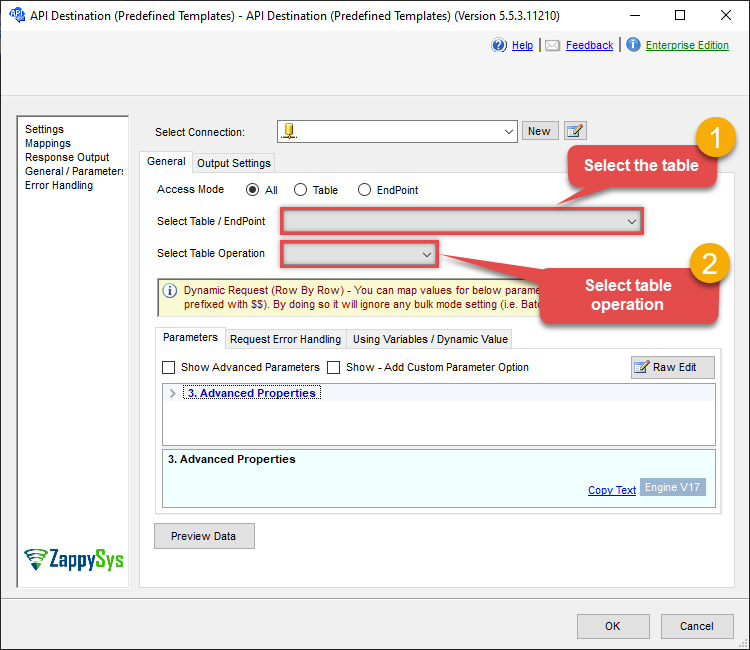Endpoint Create / Update JSON File (Generic)
Name
create_json_file
Description
Related Tables
Parameters
| Parameter | Required | Options | ||||||||||||||
|---|---|---|---|---|---|---|---|---|---|---|---|---|---|---|---|---|
|
Name:
Label: Drive Id / Shared Folder Specify a drive |
YES | |||||||||||||||
|
Name:
Label: File Id or Path (e.g. root:/somefolder/myfile.xyz: ) - Max 1000 Listed Specify a File Id or Path. Syntax: [{file-id}] -OR- [root:/{file-path}:] (Example: root:/folder/subfolder/myfile.xyz: ) |
YES | |||||||||||||||
|
Name:
Label: Default Group or User Id (additional Scopes needed to list - If fails enter manually) To list all users and groups from your organizations you need additional scopes. See connection UI - Choose User.Read.All and Group.Read.All Scopes and regenerate token. You can manually type value too if you know Group or User Id. Format is /users/{id} OR /groups/{id} |
|
|||||||||||||||
|
Name:
Label: Search Type (For UI Only - Default=Recursive - i.e. Blank) If you do not wish to see files from child folders then use Non-Recursive option. Recursive option has certain limitations (e.g. Only indexed files will appear so it takes time to show up in the list). If you do not see some files listed in the output then use Non-Recursive option (must specify Parent Folder Path in SearchPath property). |
|
|||||||||||||||
|
Name:
Label: Search Folder (For UI Only - Helps to narrow down File Selection DropDown) - Max 200 Listed This parameter is only for UI. Select this to narrow down File List Dropdown. Select Search Folder first and then select File List dropdown to see new File list (found under this selected folder). |
Output Columns
| Label | Data Type (SSIS) | Data Type (SQL) | Length | Description |
|---|---|---|---|---|
| id |
DT_WSTR
|
nvarchar(500)
|
500 | |
| name |
DT_WSTR
|
nvarchar(150)
|
150 | |
| size |
DT_I8
|
bigint
|
||
| createdDateTime |
DT_DBTIMESTAMP
|
datetime
|
||
| lastModifiedDateTime |
DT_DBTIMESTAMP
|
datetime
|
||
| webUrl |
DT_WSTR
|
nvarchar(1500)
|
1500 | |
| webUrlPath |
DT_WSTR
|
nvarchar(1500)
|
1500 | |
| createdBy_user_id |
DT_WSTR
|
nvarchar(200)
|
200 | |
| createdBy_user_email |
DT_WSTR
|
nvarchar(150)
|
150 | |
| createdBy_user_displayName |
DT_WSTR
|
nvarchar(100)
|
100 | |
| createdBy_application_id |
DT_WSTR
|
nvarchar(200)
|
200 | |
| createdBy_application_displayName |
DT_WSTR
|
nvarchar(100)
|
100 | |
| lastModifiedBy_user_id |
DT_WSTR
|
nvarchar(200)
|
200 | |
| lastModifiedBy_user_email |
DT_WSTR
|
nvarchar(150)
|
150 | |
| lastModifiedBy_user_displayName |
DT_WSTR
|
nvarchar(150)
|
150 | |
| lastModifiedBy_application_id |
DT_WSTR
|
nvarchar(200)
|
200 | |
| lastModifiedBy_application_displayName |
DT_WSTR
|
nvarchar(150)
|
150 | |
| parentReference_id |
DT_WSTR
|
nvarchar(200)
|
200 | |
| parentReference_driveId |
DT_WSTR
|
nvarchar(400)
|
400 | |
| parentReference_driveType |
DT_WSTR
|
nvarchar(100)
|
100 | |
| parentReference_name |
DT_WSTR
|
nvarchar(200)
|
200 | This is only returned when calling lookup or /children call (e.g. /items/root:/[folder-name] OR /items/[item-id] ) |
| parentReference_siteId |
DT_WSTR
|
nvarchar(200)
|
200 | |
| parentReference_path |
DT_WSTR
|
nvarchar(1000)
|
1000 | This is only returned when calling lookup or /children call (e.g. /items/root:/[folder-name] OR /items/[item-id] ) |
| fileSystemInfo_createdDateTime |
DT_DBTIMESTAMP
|
datetime
|
||
| fileSystemInfo_lastModifiedDateTime |
DT_DBTIMESTAMP
|
datetime
|
||
| folder_childCount |
DT_I8
|
bigint
|
||
| file_mimeType |
DT_WSTR
|
nvarchar(300)
|
300 | |
| file_quickXorHash |
DT_WSTR
|
nvarchar(200)
|
200 | |
| file_sha1Hash |
DT_WSTR
|
nvarchar(200)
|
200 | |
| file_sha256Hash |
DT_WSTR
|
nvarchar(200)
|
200 | |
| shared_scope |
DT_WSTR
|
nvarchar(100)
|
100 | |
| remoteItem_parentReference_id |
DT_WSTR
|
nvarchar(200)
|
200 | |
| remoteItem_parentReference_driveId |
DT_WSTR
|
nvarchar(400)
|
400 | |
| remoteItem_parentReference_driveType |
DT_WSTR
|
nvarchar(100)
|
100 | |
| remoteItem_parentReference_name |
DT_WSTR
|
nvarchar(200)
|
200 | |
| remoteItem_parentReference_siteId |
DT_WSTR
|
nvarchar(200)
|
200 | |
| remoteItem_parentReference_path |
DT_WSTR
|
nvarchar(1000)
|
1000 | |
| remoteItem_shared_scope |
DT_WSTR
|
nvarchar(100)
|
100 | |
| remoteItem_shared_sharedDateTime |
DT_DBTIMESTAMP
|
datetime
|
||
| remoteItem_sharedBy_user_id |
DT_WSTR
|
nvarchar(200)
|
200 | |
| remoteItem_sharedBy_user_email |
DT_WSTR
|
nvarchar(150)
|
150 | |
| remoteItem_sharedBy_user_displayName |
DT_WSTR
|
nvarchar(150)
|
150 | |
| remoteItem_sharepointIds_listId |
DT_WSTR
|
nvarchar(200)
|
200 | |
| remoteItem_sharepointIds_listItemId |
DT_WSTR
|
nvarchar(200)
|
200 | |
| remoteItem_sharepointIds_listItemUniqueId |
DT_WSTR
|
nvarchar(200)
|
200 | |
| remoteItem_sharepointIds_siteId |
DT_WSTR
|
nvarchar(200)
|
200 | |
| remoteItem_sharepointIds_siteUrl |
DT_WSTR
|
nvarchar(200)
|
200 | |
| remoteItem_sharepointIds_tenantId |
DT_WSTR
|
nvarchar(200)
|
200 | |
| remoteItem_sharepointIds_webId |
DT_WSTR
|
nvarchar(200)
|
200 | |
| id_path |
DT_WSTR
|
nvarchar(200)
|
200 |
Input Columns
| Label | Data Type (SSIS) | Data Type (SQL) | Length | Description | |||||||||||||||||||||||||||||||||||||||||||||||||||||||||||||||||||||||||||||||||||||||||||||||
|---|---|---|---|---|---|---|---|---|---|---|---|---|---|---|---|---|---|---|---|---|---|---|---|---|---|---|---|---|---|---|---|---|---|---|---|---|---|---|---|---|---|---|---|---|---|---|---|---|---|---|---|---|---|---|---|---|---|---|---|---|---|---|---|---|---|---|---|---|---|---|---|---|---|---|---|---|---|---|---|---|---|---|---|---|---|---|---|---|---|---|---|---|---|---|---|---|---|---|---|
| There are no Static columns defined for this endpoint. This endpoint detects columns dynamically at runtime. | |||||||||||||||||||||||||||||||||||||||||||||||||||||||||||||||||||||||||||||||||||||||||||||||||||
Examples
SSIS
Use OneDrive Connector in API Source or in API Destination SSIS Data Flow components to read or write data.
API Destination
This Endpoint belongs to the JSON File Read/Create/Update table, therefore it is better to use it, instead of accessing the endpoint directly. Use this table and table-operation pair to create / update json file:
| Required Parameters | |
|---|---|
| Drive Id / Shared Folder | Fill-in the parameter... |
| File Id or Path (e.g. root:/somefolder/myfile.xyz: ) - Max 1000 Listed | Fill-in the parameter... |
| JsonOutputFormat | Fill-in the parameter... |
| Optional Parameters | |
| Default Group or User Id (additional Scopes needed to list - If fails enter manually) | |
| Search Type (For UI Only - Default=Recursive - i.e. Blank) | |
| Search Folder (For UI Only - Helps to narrow down File Selection DropDown) - Max 200 Listed | |
| DataFormat | Notset |
| Continue On 404 Error (When item not found) | True |
| DoNotOutputNullProperty | |
| LayoutMap | <?xml version="1.0" encoding="utf-8"?> <!-- Example#1: Output all columns --> <settings> <dataset id="root" main="True" readfrominput="True" /> <map src="*" /> </settings> <!-- Example#2: Records under array <?xml version="1.0" encoding="utf-8"?> <settings singledataset="True"> <dataset id="root" main="True" readfrominput="True" /> <map name="MyArray" dataset="root" maptype="DocArray"> <map src="OrderID" name="OrderID" /> <map src="OrderDate" name="OrderDate" /> </map> </settings> --> <!-- Example#3: Records under nested section <?xml version="1.0" encoding="utf-8"?> <settings> <dataset id="dsRoot" main="True" readfrominput="True" /> <map name="NestedSection"> <map src="OrderID" name="OrderID_MyLabel" /> <map src="OrderDate" name="OrderDate_MyLabel" /> </map> </settings> --> |
| Encoding | |
| CharacterSet | |
| WriterDateTimeFormat | |

ODBC application
Use these SQL queries in your ODBC application data source:
Create / Update a JSON File in OneDrive from External Data Source (e.g. MSSQL / ODBC)
This example shows how to create / update a JSON file directly on OneDrive using streaming approach. This example reads records from Microsoft SQL Server database and writes data to JSON file on OneDrive. If file does not exists then it creates a new one. It uses LayoutMap to generate JSON with custom layout.
INSERT INTO FileReaderWriterJson
SOURCE( 'MSSQL'--OR 'ODBC'
, 'Data Source=localhost;Initial Catalog=Northwind;Integrated Security=true'
, 'select OrderId,CustomerId,OrderDate FROM Northwind.dbo.Orders'
)
WITH(
DriveId='b!XpzQciaV_k6my5II5L22J0C4iRhyz21Js89PUyZ6-w0lH0AYv_I8RJHpXZQ81efD'
, FileId='root:/test_out.json:'
--, FileId='root:/subfolder/test_out.json:'
--, FileId='01N3NxxxxxxxxxxWZYSDJ' --exising File ID
--, ContinueOn404Error=0 --Fail if file not found (Useful for overwrite mode for exising file)
, JsonOutputFormat='Multicontent' --Default , Array2D, ArrayLines ...
--, DoNotOutputNullProperty='True'
--, Encoding='UTF8' --UTF8WithoutBOM
--, WriterDateTimeFormat='yyyy-MM-ddTHH:mm:ss.fff'
--Example#1: Output all columns
, LayoutMap='<?xml version="1.0" ?>
<settings>
<dataset id="root" main="True" readfrominput="True" />
<map src="*" />
</settings>'
--Example#2: Nested JSON (Records under an array)
/*
, LayoutMap='<?xml version="1.0" ?>
<settings singledataset="True">
<dataset id="root" main="True" readfrominput="True" />
<map name="MyArray" dataset="root" maptype="DocArray">
<map src="OrderID" name="OrderID" />
<map src="OrderDate" name="OrderDate" />
</map>
</settings>'
*/
--Example#3: Nested JSON (Records under a sub document section)
/*
, LayoutMap='<?xml version="1.0" ?>
<settings>
<dataset id="dsRoot" main="True" readfrominput="True" />
<map name="NestedSection">
<map src="OrderID" name="OrderID_MyLabel" />
<map src="OrderDate" name="OrderDate_MyLabel" />
</map>
</settings>'
*/
)
create_json_file endpoint belongs to
FileReaderWriterJson
table(s), and can therefore be used via those table(s).
SQL Server
Use these SQL queries in SQL Server after you create a data source in Data Gateway:
Create / Update a JSON File in OneDrive from External Data Source (e.g. MSSQL / ODBC)
This example shows how to create / update a JSON file directly on OneDrive using streaming approach. This example reads records from Microsoft SQL Server database and writes data to JSON file on OneDrive. If file does not exists then it creates a new one. It uses LayoutMap to generate JSON with custom layout.
DECLARE @MyQuery NVARCHAR(MAX) = 'INSERT INTO FileReaderWriterJson
SOURCE( ''MSSQL''--OR ''ODBC''
, ''Data Source=localhost;Initial Catalog=Northwind;Integrated Security=true''
, ''select OrderId,CustomerId,OrderDate FROM Northwind.dbo.Orders''
)
WITH(
DriveId=''b!XpzQciaV_k6my5II5L22J0C4iRhyz21Js89PUyZ6-w0lH0AYv_I8RJHpXZQ81efD''
, FileId=''root:/test_out.json:''
--, FileId=''root:/subfolder/test_out.json:''
--, FileId=''01N3NxxxxxxxxxxWZYSDJ'' --exising File ID
--, ContinueOn404Error=0 --Fail if file not found (Useful for overwrite mode for exising file)
, JsonOutputFormat=''Multicontent'' --Default , Array2D, ArrayLines ...
--, DoNotOutputNullProperty=''True''
--, Encoding=''UTF8'' --UTF8WithoutBOM
--, WriterDateTimeFormat=''yyyy-MM-ddTHH:mm:ss.fff''
--Example#1: Output all columns
, LayoutMap=''<?xml version="1.0" ?>
<settings>
<dataset id="root" main="True" readfrominput="True" />
<map src="*" />
</settings>''
--Example#2: Nested JSON (Records under an array)
/*
, LayoutMap=''<?xml version="1.0" ?>
<settings singledataset="True">
<dataset id="root" main="True" readfrominput="True" />
<map name="MyArray" dataset="root" maptype="DocArray">
<map src="OrderID" name="OrderID" />
<map src="OrderDate" name="OrderDate" />
</map>
</settings>''
*/
--Example#3: Nested JSON (Records under a sub document section)
/*
, LayoutMap=''<?xml version="1.0" ?>
<settings>
<dataset id="dsRoot" main="True" readfrominput="True" />
<map name="NestedSection">
<map src="OrderID" name="OrderID_MyLabel" />
<map src="OrderDate" name="OrderDate_MyLabel" />
</map>
</settings>''
*/
)';
EXEC (@MyQuery) AT [LS_TO_ONEDRIVE_IN_GATEWAY];
create_json_file endpoint belongs to
FileReaderWriterJson
table(s), and can therefore be used via those table(s).
